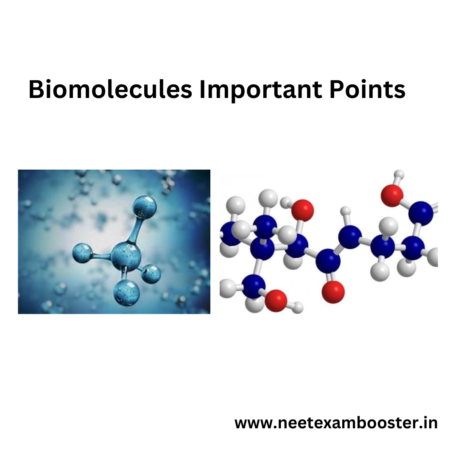Biomolecules important points – Biomolecules are the organic molecules essential for life, including the carbohydrates, lipids, proteins, and nucleic acids.
Carbohydrates provides the energy and include monosaccharides, disaccharides, and polysaccharides. Lipids are the hydrophobic molecules like fats and phospholipids, crucial for the energy storage and cell membranes. Proteins, made up of amino acids, have diverse functions like the enzymatic activity and structural support. Nucleic acids, DNA and RNA, store and transmits the genetic information. Enzymes are the specialized proteins that catalyzes the biochemical reactions.
Biomolecules plays a vital role in various biological processes and have the applications in medicine and biotechnology. Understanding their chemistry is key to understanding the life and developing the new therapies.
Biomolecules important points , Biomolecules important points , Biomolecules important points , Biomolecules important points , Biomolecules important points , Biomolecules important points , Biomolecules important points , Biomolecules important points

NCERT Chemistry Class 12 Chapter 14 – 25 Biomolecules important points
There are 25 important points on biomolecules-
- Biomolecules are the organic molecules that are essential for the life and plays a crucial roles in various biological processes.
- The four main types of biomolecules includes- carbohydrates, lipids, proteins, and nucleic acids.
- Carbohydrates are composed of carbon, hydrogen, and oxygen atoms, and they serve as a primary source of the energy in living organisms.
- Monosaccharides are simplest form of carbohydrates, and examples includes glucose, fructose, and galactose.
- Disaccharides, such as sucrose and lactose, are formed by condensation of two monosaccharide units.
- Polysaccharides, like starch and cellulose, are composed of the long chains of monosaccharides and have important structural and storage functions.
- Lipids are the hydrophobic molecules that include fats, oils, phospholipids, and steroids. They serve as the energy stores and components of cell membranes.
- Fatty acids are building blocks of lipids, and they can be saturated or unsaturated depending on presence or absence of double bonds.
- Triglycerides are most common type of lipid and are composed of glycerol and three fatty acid chains.
- Phospholipids have a hydrophilic head and hydrophobic tails, making them vital for formation of cell membranes.
- Proteins are the complex biomolecules composed of amino acids. They performs the various functions such as enzyme catalysis, structural support, and cell signaling.
- Amino acids are building blocks of proteins, and there are 20 different amino acids commonly found in the living organisms.
- Peptide bonds links the amino acids together to form polypeptides, which can fold into specific 3- D structures.
- The primary structure of a protein refers to specific sequence of amino acids, while secondary structure refers to local folding patterns like alpha helices and beta sheets.
- Tertiary structure describes overall 3-D arrangement of a protein, while the quaternary structure involves interaction of multiple protein subunits.
- Nucleic acids, including the DNA and RNA, store and transmits the genetic information.
- DNA (deoxyribonucleic acid) is a double-stranded molecule that carries the genetic instructions for development, functioning, and reproduction of all known organisms.
- RNA (ribonucleic acid) is typically single-stranded and participates in the protein synthesis, gene regulation, and the other essential cellular processes.
- Nucleotides are building blocks of the nucleic acids and consists of a sugar (ribose or deoxyribose), a phosphate group, and a nitrogenous base (adenine, thymine/uracil, cytosine, or guanine).
- Complementary base pairing occurs between the adenine and thymine (DNA) or uracil (RNA), and between cytosine and guanine.
- Enzymes are the specialized proteins that catalyze biochemical reactions by lowering the activation energy required for a reaction to occur.
- Enzymes exhibits specificity and are highly regulated, allowing for the precise control of metabolic processes.
- Coenzymes and cofactors are the non-protein molecules that assists enzymes in catalyzing reactions by providing the additional chemical groups or facilitating electron transfer.
- The study of biomolecules has led to the advancements in the fields such as medicine, biotechnology, and bioengineering.
- Understanding the chemistry of the biomolecules is crucial for comprehending fundamental processes of life and developing new therapeutic strategies.
Some Important Questions From Biology Class 11
| Chapter Name | Quiz Link |
| The Living World | Play Now |
| Biological Classification | Play Now |
| Plant Kingdom | Play Now |
| Animal Kingdom | Play Now |
| Morphology of flowering plants | Play Now |
| Anatomy of flowering plants | Play Now |
| Cell: the unit of life | Play Now |
| Biomolecules | Play Now |
| Cell Cycle and cell division | Play Now |
| Transport in Plants | Play Now |
| Structural organisation in Animals | Play Now |
| Mineral nutrition | Play Now |
| Photosynthesis in higher plants | Play Now |
| Respiration in plants | Play Now |
| Plant Growth and development | Play Now |
| Digestion and Absorption | Play Now |
| Breathing and Exchange of Gases | Play Now |
| Body fluids and circulation | Play Now |
| Excretory products and their elimination | Play Now |
| Locomotion and Movement | Play Now |
| Neural Control and Coordination | Play Now |
| Chemical Coordination and Integration | Play Now |
Some Important Questions From Biology Class 12
| Chapter Name | Quiz Link |
| Reproduction in organism | Play Now |
| Sexual reproduction in flowering plant | Play Now |
| Human reproduction | Play Now |
| Reproductive health | Play Now |
| Principles of inheritance and variation | Play Now |
| Molecular basis of inheritance | Play Now |
| Evolution | Play Now |
| Human health and disease | Play Now |
| Strategies for enhancement in food product | Play Now |
| Microbes in human welfare | Play Now |
| Biotechnology principles and processes | Play Now |
| Biotechnology and its application | Play Now |
| Organism and population | Play Now |
| Ecosystem | Play Now |
| Biodiversity and its conservation | Play Now |
| Environment issue | Play Now |





 155 out of 200 questions were directly asked from these notes in NEET 2024
155 out of 200 questions were directly asked from these notes in NEET 2024

Pingback: Chemistry Important Points For NEET For Class 11 And Class 12